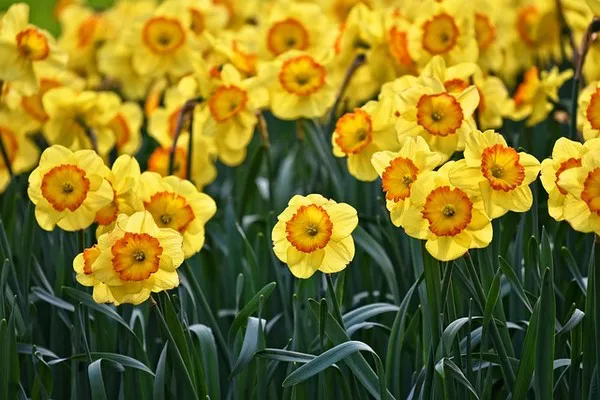Daffodils, with their vibrant colors and delicate petals, bring joy and beauty to any space they inhabit. Whether adorning a garden or gracing a vase indoors, these charming flowers captivate with their elegance. However, like all fresh blooms, daffodils have a limited lifespan once picked. To extend their beauty and preserve their freshness, understanding proper preservation techniques is essential. In this comprehensive guide, we will explore various methods to help you prolong the life of daffodil flowers, ensuring their splendor lasts as long as possible.
Understanding Daffodil Anatomy
Before delving into preservation techniques, it’s crucial to understand the anatomy of daffodil flowers. Daffodils belong to the genus Narcissus and are characterized by their trumpet-shaped central corona surrounded by six petals, known as the perianth. Each daffodil stem typically bears one or more flowers, adding to their visual appeal.
Choosing the Right Daffodils
Selecting the right daffodils is the first step in ensuring successful preservation. When choosing flowers, opt for those with buds that are just beginning to open. Avoid blooms that are fully open or showing signs of wilting, as they may not last as long once preserved.
Harvesting Daffodils
Timing is critical when harvesting daffodils for preservation. Choose to harvest early in the morning or late in the evening when temperatures are cooler, as this helps retain the flowers’ moisture. Use sharp, clean scissors to cut the stems at an angle, allowing for better water absorption.
Water Preservation Method
One of the simplest and most effective ways to preserve daffodils is by placing them in water. Follow these steps to ensure optimal results:
1. Prepare the Vase: Fill a clean vase with lukewarm water and add floral preservative to extend the flowers’ lifespan. Floral preservatives contain nutrients and antimicrobial agents that help prevent bacterial growth and keep the water clean.
2. Trim the Stems: Before placing the daffodils in the vase, trim the stems at an angle, removing any foliage that will be submerged in water. This prevents the growth of bacteria and keeps the water fresh.
3. Arrange the Flowers: Arrange the daffodils in the vase, ensuring each stem has enough space and isn’t overcrowded. Avoid placing the flowers in direct sunlight or near heat sources, as this can cause them to wilt prematurely.
4. Change the Water Regularly: To maintain the freshness of the daffodils, change the water in the vase every two to three days. Trim the stems each time you change the water to promote water absorption and prevent bacterial buildup.
5. Avoid Mixing with Other Flowers: Daffodils secrete a substance that can be harmful to other flowers, so it’s best to display them separately or with other daffodils only.
Drying Method
Drying daffodils is an excellent way to preserve their beauty for an extended period. Here’s how to dry daffodils using the air-drying method:
1. Selecting Daffodils: Choose daffodils that are in full bloom but not yet wilted. Avoid selecting flowers that are overly mature, as they may not dry well.
2. Preparing the Flowers: Remove any excess foliage from the stems and gently shake off any dirt or debris. Leave the stems long to provide ample support during the drying process.
3. Hanging the Flowers: Bundle the daffodils together in small bunches and secure them with a rubber band or twine. Hang the bundles upside down in a dry, well-ventilated area away from direct sunlight.
4. Drying Time: Allow the daffodils to dry completely, which typically takes about two to three weeks. Check the flowers periodically to ensure they are drying evenly and haven’t developed mold or mildew.
5. Preserving the Dried Flowers: Once the daffodils are fully dried, carefully remove them from the hanging bundles. Store them in a cool, dry place away from moisture and sunlight to prevent fading.
Silica Gel Method
Silica gel is a desiccant that absorbs moisture, making it an effective method for drying flowers quickly while preserving their shape and color. Here’s how to use silica gel to preserve daffodils:
1. Preparing the Flowers: Trim the stems of the daffodils and remove any excess foliage. Place the flowers upright in a container, ensuring they are not touching each other.
2. Covering with Silica Gel: Pour silica gel over the daffodils until they are completely covered. Gently pat down the silica gel to ensure it fills any gaps between the flowers.
3. Drying Time: Seal the container with a lid and leave it undisturbed for approximately one week to allow the silica gel to absorb moisture from the flowers.
4. Removing the Flowers: Carefully brush away the silica gel from the daffodils using a soft brush or your hands. Be gentle to avoid damaging the delicate petals.
5. Preserving the Dried Flowers: Once the flowers are free of silica gel, store them in a dry, cool place away from direct sunlight. Display them in a vase or use them in floral arrangements as desired.
Conclusion
Daffodils are cherished for their beauty and symbolism of renewal and hope. By following proper preservation techniques, you can extend the lifespan of these delightful flowers and enjoy their elegance for an extended period. Whether using water preservation, air-drying, or silica gel methods, taking the time to care for daffodils ensures their splendor remains preserved for all to admire. With the guidance provided in this comprehensive guide, you can confidently preserve daffodil flowers and enhance the aesthetic appeal of any space they adorn.


